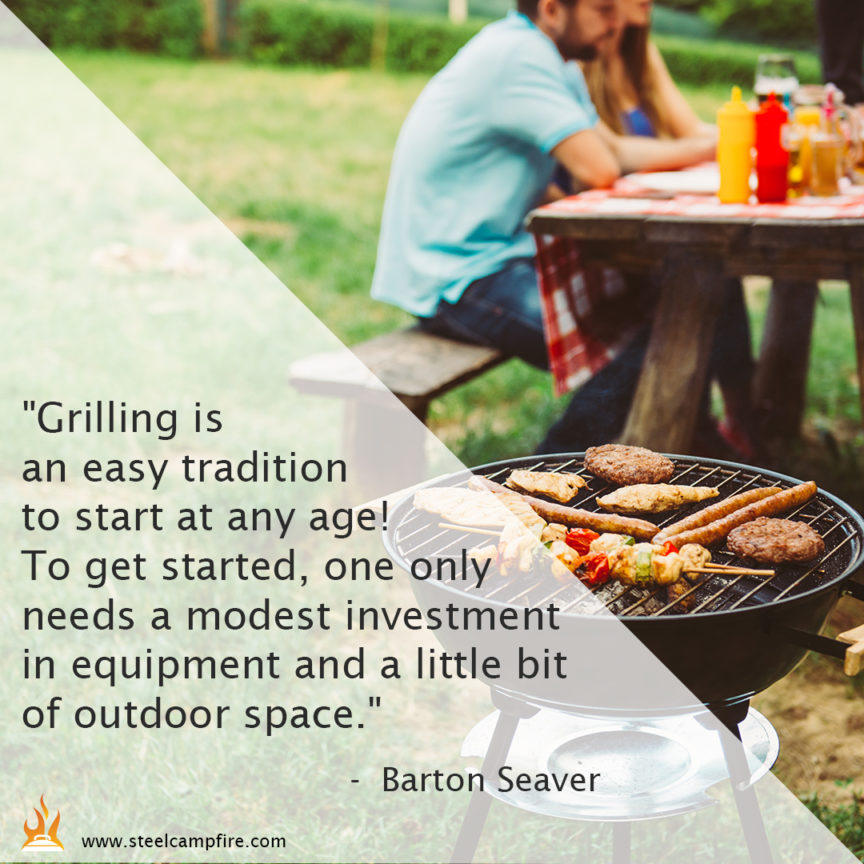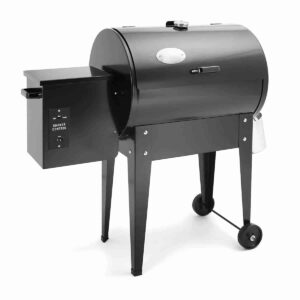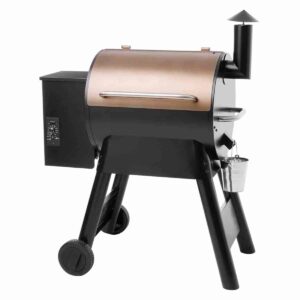Let’s say you have a grill and are looking for a smoker. You could buy a separate one, but now you have two pieces of equipment that you need to find a place for. Or you could get yourself a single, versatile grill that also can smoke a ham, broil a chicken, or bake a pizza. If that sounds like something that you’re interested in, then let’s introduce you to a Kamado.
What are the 5 best Kamado grills for the money? To determine which Kamado grill is best, you need to decide how you will be using it. Besides being versatile, a Kamado has additional benefits. Using a kamado is not much different from a traditional grill, so learning how to use them is not complicated.
The word Kamado is a Japanese word for a stove or oven. Literally, it means “a place for the cauldron.” Unlike the metal that we picture, a Kamado is a ceramic cooking unit.
Before you buy, read on for our reviews of the best Kamado. We’ll also help you understand how a Kamado works and tips for using one.
What are the Benefits of a Kamado?
Here’s an overview of why an investment in a Kamado pays off.
- Multi-purpose. You can grill, bake, or smoke. Cook some burgers? Grill a steak? Roast a chicken? Barbeque ribs? Bake a pizza? Cookies for dessert—a Kamado can do that too.
- Taste. No presoaked charcoal or lighter fluid taste? With a Kamado you use lump charcoal to get better flavor. A smoker accessory adds to the Kamado’s skill set.
- Quick Start. Because of their shape, lump charcoal can be ready in as little as 15 minutes.
- Temperature Range. Kamado’s get up to 700 degrees due to the design and materials used. Adjustable openings let you control the temperatures.
- Even heating. The ceramic walls mean fewer hotspots and more even heat distribution
- Cleaning. Less charcoal means less to clean-up. Hotter temps mean even less to clean.
The Best Kamados of 2019?
The best Kamado for you is the one that best meets your needs. Are you planning to have large get-togethers? A couple of friends over to watch a game? Or a smaller, more intimate event? There’s a Kamado for every purpose.
It can be quite confusing to sift through all the reviews and information because Kamado’s come in three sizes. So we decided to group our top choices into the three sizes—which we’ve decided to call family (1 -4), a few friends (4-8), or picnic (10+).
At-A-Glance: Our top five Kamados
- Grill Dome Infinity Series
- Kamado Joe Junior
- Coyote Asado Ceramic Grill
- Primo Oval XL 400
- Kamado Joe III
Let’s look at these in more detail.
Family
There aren’t as many smaller models, which made picking our top two choices a little easier.
Name | Size | Key Feature | Price Range |
Grill Dome Infinity Series Small | 16 inches, 100 pounds | Thicker ceramic for increased heat retention | $550-650 |
Kamado Joe Jr. | 16 inches, 68 pounds | Lighter and less expensive | $450-550 |
Grill Dome Infinity Series Small
Grill Dome is a relative newcomer to the Kamado grill scene. (Check current price on Amazon of large Grill Dome) But, we believe it has staying power to be a major player. Two main reasons for that—thicker ceramic and lifetime guarantee.
Things We Like
- That thicker ceramic really got our attention. After all, one of the reasons to invest in a Kamado is its versatility. The thicker the ceramic, the better your control over the grill’s heat.
- Grill Dome has the best warranty in the Kamado world—lifetime. The longest warranty you’ll get from the other manufacturers is five.
- The hinge design is also superior to other Kamados
Things We Don’t Like
- The lack of multiple cooking surfaces–Grill Domes have a single grid–means less versatility. With grills that have dual-cooking capabilities, you can put the veggies you want to grill on the higher level, and your steak on the lower level and have both ready at the same time. Not so with single grids.
- Other Kamados have a superior top vent. Grill Dome’s simpler vent means a little less reliability on temperature control. Why make such a powerful grill and then skimp on a top vent?
Kamado Joe Junior
The first thing that got our attention was the price. A hundred dollars less for a product of similar size and an excellent track record is a great value. (check price on Amazon) And the Kamado Joe brand has been around long enough that it’s clear they are here to stay.
Things We Like
- Split level cooking. As mentioned in our review of Grill Dome, split level cooking allows for more flexibility.
- Accessories that come with the unit. A grate gripper, ash tool, and heat deflector are standard. Not only is this a money saver, but it also saves time having to hunt those things down. And time is money, right?
Things We Don’t Like
- Well, a five-year warranty is better than none, but once a lifetime would be better still. And since there’s a competitor—why not match them?
- The stand it comes with has no wheels. Which means moving Junior will require two people. Due to their bulky shape Kamados it takes two to move them.
Bottom Line
This is a tough call. Both make it into our top 5 of 2019, but making a final call is difficult. The Grill Dome has thicker ceramic walls and an unlimited warranty. But the price is one hundred dollars more, and you’ll still have to buy accessories. And then there’s a lack of split-level cooking.
We believe that for a small Komodo ceramic width is not as important as for larger models. Plus, if 68 pounds is heavy, 100 is much heavier. So our final recommendation is the Kamado Joe Junior.
A Few Friends
We think these mid-sized grills are the most popular option for most people. They are the perfect size to replace the typical backyard grill. Be prepared for some sticker shock, though.
Name | Size | Key Features | Price Range |
Coyote Asado Ceramic Grill | 28.5 inches, 250 pounds | Dual vent system for more precise temperature management | $1,200-1,300 |
Primo Oval XL 400 Ceramic Kamado Grill | 27.5 inches, 250 pounds | The oval shape that gives more room inside for smoking and roasting | $1,400-1,500 |
Coyote Asado Ceramic Grill
We were drawn to the Coyote because of a couple of small touches that might not seem like much at first until you realize that it shows a company wanting to go the extra mile. (check price on Amazon) These include the ash tool, ceramic feet for built-in installations, and touch-up paint.
Things We Like
- In a Kamado, anything that lets you control your temperature is important, especially for smoking, which requires a steady, low temperature.
- Although it doesn’t sound like much, adding ceramic feet that let you install it as a built-in is one of those extra touches. Another is providing a small bottle of touch-up paint.
Things We Don’t Like
- A stainless-steel hinge doesn’t have the strength and durability of a powder-coated steel.
- Accessories are not included.
Primo Oval XL 400 Ceramic Kamado Grill
A Kamado can multi-task because of its ceramic exterior and its shape. By modifying the shape, so it is wider than your standard Kamado, you will have more flexibility for what you can cook. The Oval shape doesn’t make much difference in the smallest Kamados, but with this size, it’s good to be able to smoke a medium-sized ham or a larger chicken if that’s what you want to do.
Things We Like
- The split and multi-level grids. We’ve already mentioned the advantage of multi-level grids. Split grids will let you continue to broil a chicken while searing a steak.
- An optional charcoal divider. This accessory helps the Kamado with its multi-tasking ways
Things We Don’t Like
- Obviously, nobody likes a higher price. But the Oval shape provides better roasting and smoking capabilities.
- No pull-out ashpan. You’re going to be using more charcoal, so why not make cleaning out your grill a little easier?
Bottom Line
Another tough call. We like saving a couple hundred dollars. But we’re buying a Kamado because it’s practically an outdoor kitchen. You can’t go wrong with either grill, but we feel that the Primo is worth the extra money.
Kamado Joe III
We had no choice picking a Kamado that will feed twenty people at once—the Kamado Big Joe III. (check current price on Amazon) At these prices, you don’t want a complete package, and that’s what you’ll get with the Big Joe III.
Name | Size | Key Features | Price Range |
Kamado Big Joe III | 58.4 inches, 487 pounds | Accessories | $2,400-2,500 |
Things We Like
- Ash pullout pan. At this size, you’re guaranteed to have some ashes. If the competition had these, we wouldn’t make a big deal about this—but they don’t.
- Although it’s an optional item, the Big Joe is the only Kamado that has a rotisserie kit. Seriously? Do we even need to point out how this is an advantage?
Things We Don’t Like
- The weight. Of course, the other Kamados of this size are in the 400-500 pound range, so no matter what you buy, you’re going to be glad the stand comes with wheels, and you’re going to need a couple of folks to help you put it in place.
Bottom Line
If you want to go all-in, this is our recommendation. ‘Nuf said.
What is the Largest Kamado Grill?
The Big Joe III is big, but the Green Egg is bigger yet. Big Joe three has a 24-inch diameter while the Big Green Egg 2XL’s diameter rounds out at 29 inches.
But. Big Joe has a larger overall cooking area—864 sq. inches, versus the 672 sq. inches of the Big Green Egg. And weight? Big Joe wins out again at 487 pounds. That’s a 100 pounds more than the Big Green Egg weight of 375.
So, you get to pick the winner. Big Green Egg will no doubt claim it’s the biggest, but Big Joe will claim that two out of three wins.
Whoever wins, their both large, able to cook 35-40 burgers at once, or 10+ chickens, or 18-20 steaks, or 15+ racks of ribs hung vertically, or even a small suckling pig (separate accessories needed for the last two). That’s quite a cookout.
Size Isn’t Everything
In the size competition, we’re calling the Green Egg the winner. But big isn’t always better—especially when it comes to features and accessories. Check out the differences between the Big Egg and the Big Joe.
2XL Big Egg | Big Joe | |
Cooking System | · One level system included—multi-level racks sold separately · Felt gasket · Top vent rain shield sold separately · | · Divide and Conquer System—a multi-level, half rack design so you can cook different types of food at the same time · Fiberglass, wire-mesh gasket · Vent stays in position, provides consistent airflow, and keeps rain out |
Accessories | · Also sold separately, half-moon heat deflector plates · Other accessories sold separately | · Half-moon heat deflectors · Ash tool for adjusting hot coals and removing coal ash · Stainless steel gripper so you can safely adjust and lift hot grates · Smoke chamber insert to create cyclonic airflow |
You can order the Big Joe online at Amazon (Prime members get all 455 pounds shipped for free). Or you can drive to Home Depot or Ace to look under the lid before you buy.
If you want to buy a Green Egg, you can’t go on-line, and you can’t buy it directly from the manufacturer. Instead, you’ve got to find a dealer. The website is easy to use—type in a Zip Code or city and find a dealer. If you manage to find one on-line, through a second dealer, then the company will not honor the grill’s warranty.
As you can see, a Kamado Grill is not your typical backyard grill. But if you’re new to the world of Kamado Grill’s, you might have a few questions about how they work, how they’re built, and how to operate them. Rest easy: you’ve come to the right place for the answer.
What’s a Kamado Made Of?
Traditionally, Japanese Kamados were made from clay or other ceramic materials. Clay has a long tradition in cooking. The Egyptians and Mesopotamians are credited with being the first to use clay in cooking. After starting a coal fire on a hearth, they would take a clay pot and turn it around before placing it on the hearth. The “Tandur” oven, or tandoor, was an improvement that led to more consistency in baking.
Other clay cooking vessels developed in China, also using ceramic materials for baking. In Japan, what was to become the Kamado started as a clay pot with a domed lid. Eventually, portable kamados were built; these were known as “mushikamados.” By this time, dampers and draft doors had been added to better control heat. Soldiers brought them back from Japan after the second world war, which is how Americans were introduced to them. Eventually, the mushi was dropped, and the clay, egg-shaped grills became kamados.
Most Kamados are still made of refractory ceramics, which are ceramics that can withstand higher heat than other ceramics. Constructing the grills from these materials meant the grill could keep steady temperatures even at high temperatures. Also, improved insulation meant a fire could be kept hot with less fuel. Finally, earlier Kamados that used regular ceramics had a tendency to crack.
How Do I Operate a Kamado?
Operating a Kamado is similar to any grill. The charcoal will get warmer more quickly, and you have to be careful about how you work with higher heat.
- Fill firebox just above airholes
- Once the fire is lit, open bottom and top vents so that you have maximum airflow.
- Ten to fifteen minutes later, begin manipulating the vents until you get the temperature you want
- Three to Four hundred degrees are the most common temperatures for direct grilling
- If you’re cooking at temperatures above 500 degrees, you want to be careful to avoid something called flashback. This happens when you open the lid too quickly. A rush of oxygen will charge into the grill and then come back at you in the form of white heat.
- Avoid this by slowly lifting the lid a couple of inches, wait 5 or 10 seconds, and then lift it the rest of the way.
Starting a Kamado—Three Methods
Since you don’t want that lighter fluid taste (and the manufacturers strongly advise against using lighter fluid), consider using one of these methods:
Lighter cubes.
Place two or three lighter cubes on top of the charcoal and light it up. These cubes are readily available anywhere you buy your grilling supplies. They are made of paraffin wax, which is a fancy way of saying a white wax that is a by-product of oil, shale, or coal.
Electric Starter.
- Maybe you didn’t know this was a thing, but an electric starter sits on top of a bed of charcoal. After a few minutes, your charcoal is burning—if you plugged the starter in! Unless there’s a plug close, you’ll need an extension cord. Seems like it’s a little too much work. This might be one of those for-the-guy-who-has-everything gifts. Still, if you’re interested, the Kamado-Joe KJ-ES gets high marks.
Charcoal Chimney.
- If you want something more resourceful and old-timey than lighter cubes, a charcoal chimney is the way to go. You load the charcoal in the chimney, put some crumpled up newspaper underneath. Light the paper and wait a couple of minutes. The charcoal should be glowing and ready to put into your Kamado. To see how they work—check out this video.
Using Your Kamado to Smoke and Roast
Most folks, when they want to smoke a ham, buy a separate smoker. Because of the Kamado’s egg-like shape, smoking is a natural. Here are a few tips on how to use that Kamado to roast yourself a chicken or smoke that ham.
- For smoking and roasting, you’re going to be using the deflector plate that came with the unit.
- Once the kamado’s temperature is where you want it, place the stand in the kamado and deflector plate inside
- Ideal smoking and roasting temperatures are between 180 to 225 degrees.
- After you have prepped your food, the deflector plate is ready to start roasting.
Baking With Your Kamado Grill
Since baking is a feature that is unique to a kamado grill, let’s take a few minutes to go over the basics.
- Start your grill the same way—light the charcoal, open the vents, and wait until the charcoal is lit and ready to go.
- This time you’re going to place a heat deflector and pizza stone into the grill.
- Give the pizza stone 10-15 minutes to heat up
- Get the temperature inside to be 425 to 550 are the typical baking temperatures
- Slide the pizza on the stone (you might want to season the stone with some cornmeal)
- Close the lid and wait about 15 minutes
Cleaning Your Kamado Grill
Cleaning your grill is similar to using a self-cleaning oven.
- Light the grill
- Bring its temperature up to 600 degrees
- Burn it, with the lid closed, for 15 to 20 minutes
- When it cools, brush away any remaining char
- Every five to 10 cookouts, you’ll want to remove the ash that’s gathered.
- When you get ready to do so, stir remain
- Check the air holes to make sure a small piece of charcoal isn’t blocking one
- Afterward, remove the ashes through the opening, either using an ash can or an ash collector
Final Thoughts
If you’re thinking these things are kind of pricey, you’re correct. Remember that you’re buying more than a grill. With a Kamado you can grill, roast, smoke, or bake. Think it of an outdoor oven that will keep do anything you want an outdoor grill to do—except get you another drink!
Check out our Recent Posts
Z Grills Review
If you’re looking for a grill that will last, Z Grills is the way to go. Z grills are made of the best quality materials...
Read MorePit Boss Pellet Grill Review
Pit Boss is one of many when it comes to manufacturers of wood pellet grills and smokers. If you have spent any amount of time...
Read More10 Fun Benefits of Taking an Online Cooking Class
There’s never been a better time to take an online cooking class. With the continued popularity of online learning, there are more and more exciting...
Read More



